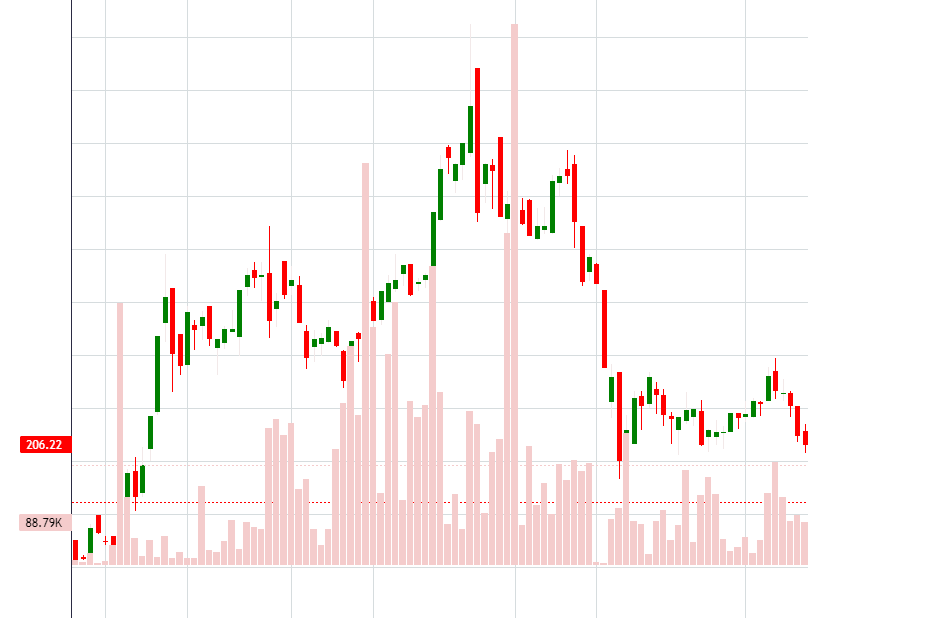Tutorial to build TradingView chart with real-time blockchain data (Streaming API version)
We will be building the demo in React using the lightweight-charts library.
This is how it will look finally.

Step 1: Set up your React Environment Ensure you have a React application set up and ready for use. You should have a working React project with the necessary dependencies already installed. Create a project with
npx create-react-app demo
Step 2: Import Dependencies
In your React component file, import the required dependencies at the beginning of your file. These include React, useState, useEffect, useRef, and the necessary charting library (in this case, lightweight-charts).
import React, { useState, useEffect, useRef } from "react";
import { createChart, CrosshairMode } from "lightweight-charts";
import { getTimestampInMilliseconds } from "./utils";
Step 3: Create the React Component
Create a React functional component for your TradingView chart. You can name it something like TradingViewChart.
export default function TradingViewChart() {
// State and Ref Declarations
const [resdata, setData] = useState([]);
const chartContainerRef = useRef();
const chart = useRef();
// useEffect Hook
useEffect(() => {
// Initialize the TradingView chart
chart.current = createChart(chartContainerRef.current, {
// Chart configuration options
// ...
});
// Fetch and process data using the Streaming API
const fetchData = async () => {
// Fetch data from the API
// ...
if (response.status === 200) {
// Process and format the data
// ...
// Create and populate candlestick and volume series
// ...
} else {
console.log("error");
}
};
fetchData();
}, []);
return (
<div>
<h1>Trade Data</h1>
<div
ref={chartContainerRef}
className="chart-container"
style={{ height: 800, width: 800 }}
/>
</div>
);
}
Step 4: Configure the Chart
In the useEffect hook, initialize the TradingView chart with the desired configuration options. Customize the chart layout, appearance, and any other settings based on your requirements.
chart.current = createChart(chartContainerRef.current, {
width: chartContainerRef.current.clientWidth,
height: chartContainerRef.current.clientHeight,
layout: {
backgroundColor: "#253248",
textColor: "rgba(255, 255, 255, 0.9)",
},
crosshair: {
mode: CrosshairMode.Normal,
},
rightPriceScale: {
visible: false,
},
leftPriceScale: {
visible: true,
},
timeScale: {
borderColor: "#485c7b",
},
});
Step 5: Fetch Data from the Streaming API
Create an async function named fetchData to fetch data from the Streaming API. You should use the fetch method to send a POST request to the API and retrieve the data. This query below gets 200 records of USDT-WETH OHLC data. Adjust the query and variables to suit your data requirements.
const fetchData = async () => {
const response = await fetch("https://streaming.bitquery.io/graphql", {
method: "POST",
headers: {
"Content-Type": "application/json",
},
body: JSON.stringify({
query: `
{
EVM(network: eth, dataset: combined) {
DEXTradeByTokens(
orderBy: {ascending: Block_Date}
where: {Trade: {Currency: {SmartContract: {is: "0xdac17f958d2ee523a2206206994597c13d831ec7"}}, Side: {Currency: {SmartContract: {is: "0xc02aaa39b223fe8d0a0e5c4f27ead9083c756cc2"}}}}}
limit: {count: 200}
) {
Block {
Date(interval: {in: days})
}
volume: sum(of: Trade_Amount)
Trade {
high: Price(maximum: Trade_Price)
low: Price(minimum: Trade_Price)
open: Price(minimum: Block_Number)
close: Price(maximum: Block_Number)
}
count
}
}
}
`,
variables: "{}",
}),
});
// Process and populate the chart with the retrieved data
// ...
};
Step 6: Process and Populate Data
Within the fetchData function, process and format the retrieved data according to your needs. This includes extracting relevant information and populating the candlestick and volume series of the chart.
if (response.status === 200) {
// Process and format the data
const recddata = await response.json();
const responseData = recddata.data.EVM.DEXTradeByTokens;
const extractedData = [];
const extractedvol = [];
responseData.forEach((record) => {
// Extract necessary fields from Object
const open = record.Trade.open;
const high = record.Trade.high;
const low = record.Trade.low;
const close = record.Trade.close;
const recvol = parseFloat(record.volume);
const resdate = new Date(record.Block.Date);
const extractedItem = {
open: open,
high: high,
low: low,
close: close,
time: resdate.toISOString().split("T")[0],
};
// Push the extracted object to the extractedData array
extractedData.push(extractedItem);
const extractvol = {
value: recvol,
time: resdate.toISOString().split("T")[0],
};
extractedvol.push(extractvol);
});
// Create candlestick and volume series on the chart
// ...
const candlestickSeries = chart.current.addCandlestickSeries({
upColor: "#008000",
downColor: "#FF0000",
borderDownColor: "#FF0000",
borderUpColor: "#008000",
wickDownColor: "#FF0000",
wickUpColor: "#f2e9e9",
});
candlestickSeries.setData(extractedData);
const volumeSeries = chart.current.addHistogramSeries({
priceFormat: {
type: 'volume',
},
scaleMargins: {
top: 0.8,
bottom: 0,
},
overlay: true,
priceScaleId: '',
color:"#f4cccc"
});
volumeSeries.setData(extractedvol);
} else {
console.log("error");
}
In this step, we format the data making it suitable for chart creation. The below snippet fetches open,high,low,close from each record in the response and creates a new variable extractedItem. The date field, which is received in the format of 'YYYY-MM-DD 00:00:00Z' is formatted to YYYY-MM-DD.
const open = record.Trade.open;
const high = record.Trade.high;
const low = record.Trade.low;
const close = record.Trade.close;
const recvol = parseFloat(record.volume);
const resdate = new Date(record.Block.Date);
const extractedItem = {
open: open,
high: high,
low: low,
close: close,
time: resdate.toISOString().split("T")[0],
};
Step 7: Render the Chart
Render the TradingView chart within your React component by returning the chart container div inside the component's JSX.
return (
<div>
<h1>Trade Data</h1>
<div
ref={chartContainerRef}
className="chart-container"
style={{ height: 800, width: 800 }}
/>
</div>
);
Step 8: Customize Further
Customize the chart appearance, colors, and layout to meet your specific needs by adjusting the configuration options and series settings in the createChart and data population sections of your code.
That's it! You now have a React component that plots a TradingView chart using the Streaming API.
You can find the complete code here